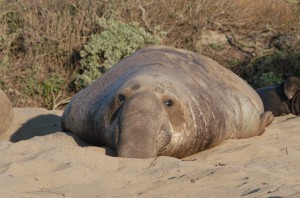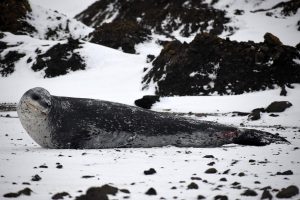Northern Elephant Seals


Effects of Multiple Stressors
How an animal survives, grows, and reproduces within its environment is influenced by its response to intrinsic and extrinsic stressors. Intrinsic stressors can arise from life history stages and result in significant changes to homeostasis. Extrinsic stressors, environmental factors that alter physiology and behavior of an individual, have been the focus of studies aiming to understand the effects of the stress response. Responsiveness of the neuroendocrine stress axis, hypothalamic-pituitary adrenal or HPA, has been studied extensively in elephant seals, making them an excellent system for investigating links between stressors, at-sea behavior, and health. Together, we developed a multi-investigator interdisciplinary study using the northern elephant seal as a model system to significantly improve our understanding of the response of marine mammals to exposure from multiple stressors. Our team is integrating physiological and ecological approaches including immunology, stress physiology, toxicology, animal behavior, population biology, and life history theory and will examine cumulative effects of exposure to multiple stressors in elephant seals. This research focuses on specific responses of individual animals, but by incorporating information from our long-term database on elephant seal population demographics we will extend this understanding to population-level impacts. Our effort will be integrated into the proposed Interdisciplinary Working Group that will be led by The Sea Mammal Research Unit at St Andrews University entitled “Towards an Understanding of the Cumulative Effects of Multiple Stressors on Marine Mammals”. Read more about our progress on this project here.
Bioacoustics
Vocal signaling plays an important role in the social interactions of many animals, and has the potential to convey biologically relevant information to receivers, including motivational cues (such as level of arousal or willingness to fight), and individual characteristics (such as identity, size, group association, and dominance status). This can be especially important during reproductive activities, as vocal signaling often mediates interactions between breeding partners, competitive rivals, and mother-offspring pairs. The bioacoustics research project aims to understand how northern elephant seals (Mirounga angustirostris) use vocalizations to communicate biologically important information to one another during their annual breeding season. Specifically, we are examine how males use vocal cues to settle competitive interactions during high stakes competition over access to females during the breeding season. Male elephant seals establish dominance hierarchies during the winter breeding seasons. Competition between males is intense, with only a subset of individuals ever gaining access to breeding females. While dominance relationships are typically established through fighting, these hierarchies are maintained through the use of stereotypic threat displays that include vocalizations. These displays play an important role in settling otherwise costly interactions between competing males, as they often settles disputes between rivals without individuals having to engage in energetically costly fights. To explore the function of these special acoustic displays, we combine identification and marking, GPS re-sight data, behavioral observations, photometric analysis, playback experiments, and acoustic recording and analysis techniques to acquire detailed information about the behavioral and acoustic patterns exhibited by individual animals.
California Sea Lions

Liz just completed a field season deploying satellite tracking tags on juvenile animals at Año Nuevo Island. Read more about it here.
We are just starting a new project where we will deploying satellite tracking tags to monitor the movement of animals as part of a collaborative project looking at White Shark movement in Monterey Bay. See what our tagged animals are doing here.
Leopard Seals
Dan and Sarah just completed a field season deploying satellite tags on adult and juvenile leopard seals at Cape Shirreff, Antarctica. Read more about it here.
Weddell Seals
Luis is down in Antarctica working on a project studying Weddell seals. You can read more about it here.

